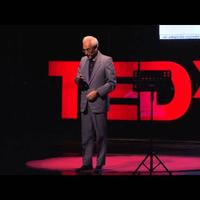The new renaissance | Darius Mahdjoubi
صبح روز جمعهتون به خیر.
از اینکه لطف کردید و صبح جمعهتونُ با من شریک شدید خیلی متشکرم.
اسم من هست داریوش محجوبی، و امروز من میخوام براتون یه قصه بگم.
قصهی من هست قصهی رنسانسِ نو. قصهی من هم قصهی گذشتهست و هم قصهی آینده.
قصهی من چهار تا بخش خواهد داشت: رنسانسِ اروپایی، عصرِ اکتشاف، چاپ و آینده.
حدود شش قرن قبل، در ابتدای قرن پونزدهم میلادی یا سالهای هزار و چهارصد،
تحولی در اروپا شروع شد که بعدها رنسانس اروپایی نام گرفت.
رنسانس اروپایی ساختارهای جهان رو تغییر داد
ساختارهای فعلیِ جهان، همه تحت تاثیر رنسانس اروپاییایه.
رنسانس اروپایی تحول بسیار مهمی بود،
ولی رنسانس اروپایی نمیتونه آخرین تحول بشر باشه.
قبل از رنسانس اروپایی تحولهای دیگهای بوده و بعد از رنسانس اروپایی
تحولهای دیگری خواهد بود.
صحبت ما اینه که تحول ساختاریِ بعدی کی اتفاق میافته؟ مشخصههاش چیه؟
این صحبت اصلیِ ماست.
رنسانس اروپایی به طور سمبولیک میگن سال هزار و چهارصد
قبل از هزار و چهارصد عصر قرون وسطا سدههای میانهست
و بعد از اون رنسانس انجام میشه.
این تحول از قرون وسطا به رنسانس، حاصل یک ساختار، یک تغییر در بینش و نگرشه.
ساختار تکنولوژیک آنچنان عوض نمیشه.
بینشها عوض میشه که ساختار از قرون وسطا میره به رنسانس.
در این مورد هزاران کتاب نوشته شده. من این تغییرُ با دو تا نقشه خدمتتون ارایه میدم.
این نقشهی دنیاست در سال هزار و سیصد و شصت و سهی میلادی،
درست در مرز قبل از رنسانس.
این نقشه به واقع مرتبط است با این نقشهی کوچولویِ سمت راست،
که بهش میگن نقشهی TO ، همونطور که میبینید یه O داره و یه T.
نقشهی TO ساختار تئوریک کلیسا بود در دروان قرون وسطا.
کلیسا تعیین میکرد که واقعیت چطوری باید باشه.
کلیسا تعیین میکرد که شکل دنیا چه شکلی باید باشه.
کلیسا میگفت که جهان باید صاف باشه، اگرچه کُرَوی بودنِ زمین شناختهشده بود.
کلیسا میگفت که جهان باید دایرهای باشه.
کلیسا میگفت که مرکز این جهان باید شهر بیتالمقدس باشه.
کلیسا میگفت که جهان بر مبنای یک صلیب تشکیل شده،
پایهی این صلیب دریای مدیترانهست،
یک بازوی صلیب دریای سرخه، یک بازوی دیگهی صلیب دریای سیاهه.
اون Tای که وسط میبینید یک دونه صلیبه.
نقشهی دوم میآد و سعی میکنه این نظرات کلیسا رو متجلی کنه.
بگه که کلیسا درست میگه. نقشهی دوم این نقشهی تئولوژیکه.
بالای هر دوتای این نقشهها طرف شرقه. برای اینکه یه کمی معمولتر بشه
من هردوتا نقشه رو میچرخونم تا بالای هر دوتا نقشه بشه شمال.
این نقشه به واقع بخشیست که الان ما میشناسیم. این نقشه ساختار فعلیِ جهانه
متناسب با همون نقشهی بزرگ. نقشهی پایینی اگه دقت کنید سمت چپاش
تنگهی جبلالطارقه، وسط دریای مدیترانهست، پایین دریای سرخه، و بالا دریای سیاه.
اون نقشه بزرگه هم، همین رو داره نشون میده
سمت چپِ گوشهاش تنگهی جبلالطارقه، اون دریای وسط دریای مدیترانهست،
و سمت راست دریای سرخه که سرخ نشون داده شده
نکتهی جالب در این سه تا نقشه اینه که مرکز هر سه تا نقشه، بیتالمقدسه.
یعنی اونهایی که اون نقشه رو کشیدند، اومدند در جهت ثابتکردنِ نظریات کلیسا
که مرکز جهان بیتالمقدسه، آن بخشی از دنیا رو ارایه دادند،
که مرکز اش واقعا بیتالمقدس هست.
تو اون نقشهی بزرگ، یک رود دیده میشه، رودِ شرقی-غربیه. این رود، رودِ نیلِ
ما میدونیم که نیل، شمالی-جنوبیه. بنابراین سوال اینه که چرا نیلُ شرقی-غربی نشون دادن؟
و جواب قضیه اینه که اگر رود نیل رو تو اون نقشهی بزرگ شمالی-جنوبی نشون میدادند،
مرکز نقشه دیگه بیتالمقدس نمیشد.
در نتیجه در جهت اثبات نظرات کلیسا که مرکز جهان بیتالمقدس هست،
هیچ اِبایی از این نداشتند که جهت نیل رو هم عوض کنند.
این نقشه به واقع تفکر قرون وسطایی رو نشون میده که ما بهش میگیم استدلال معکوس.
یعنی شما اول نتیجه رو مشخص میکنید، تمام مقدمات رو میچینید تا به همون نتیجه برسید.
حالا این نقشهی بعدی، نقشهی جهانه در سال هزار و چهارصد و نود.
یعنی درست صد سال بعده، منتها بعد از رنسانسه.
و همونطور که ملاحظه میکنید، این نقشه با ساختار فعلی خیلی تفاوت نمیکنه.
تفاوتِ دوتا نقشه، در دوتا بینشه: نقشهی اولی بر مبنای بینشهای قرون وسطاایه
و نقشهی دوم بر مبنای بینشهای رنسانسایه.
نکتهی جالب در این نقشه اینه که رود نیل با تمام جزییاتاش کشیده شده.
آنهایی که اون نقشهی قبلی رو کشیدند، به همین اطلاعات دسترسی داشتند.
منتها بینشاشون متفاوت بود، بینش این بود که نظرات کلیسا اعلام بشه.
این نقشه، نقشهی رنسانسایه بر مبنای واقعیتها کشیده شده،
و البته دیگه بیتالمقدس مرکز نقشه نیست.
این نقشه مسیر مارکوپولوئه که صدسال قبل از اون نقشهی قبلی اومد از اروپا رفت به چین.
مسیر بالای خط قرمز، رفتِ مارکوپولو رو نشون میده.
اونهایی که اون نقشهی کوچولو رو کشیدن به این اطلاعات دسترسی داشتند.
ولی بخشی از جهان رو انتخاب کردند که مرکز اش بیتالمقدس میبود.
حالا این نقشه نکاتی داره که هنوز برای ما جالبه.
خط بالایی، جادهی زمینیایست که ما بهش میگیم جادهی ابریشم.
از اروپا میاومد، میرفت به چین، و قسمت عمدهاش از داخل فلات ایران عبور میکنه.
مارکوپولو از این مسیر برنگشت بلکه از اون مسیر سبزرنگ برگشت،
که بهش گفته میشه جادهی ادویه. جادهی ادویه و جادهی ابریشم
دو تا جادهی موازیِ هم بودند، که ساختار تجارت دنیا رو تشکیل میدادند.
البته اینها دوتا جادهی مشخص نیستند، هردو شون دوتا شبکه هستند
که دنیا رو به هم وصل میکردند و در عین حال مسیرهایی دارند که تو نقشهی مارکوپولو نیست
ولی نکتهی جالب، موقعیت عَدَن است و هرمز: هرمز شهریست یا بندریست
که دوتا جادهی ابریشم و ادویه رو به هم وصل میکنه.
همچین نقشی رو عدن هم داره در اون گوشه. هرکس که این دو تا نقطه رو کنترل میکرد
در اون روزگار، ساختار تجارت جهانی رو کنترل میکرد.
میرسیم به سال هزار و سیصد و پنجاهِ میلادی درست قبل از رنسانس در انتهای قرون وسطا.
یک کتابی هست به نام: "Before European Hegemony"
و این کتاب ادعا میکنه و یا ثابت میکنه و یا بیان میکنه که در دوران قبل از رنسانس،
هشت مرکز قدرت جهانی وجود داشت. این مراکز عبارت بودند: در بالا اروپای
شمالی، اروپای جنوبی، خاورمیانه، مصر، هند غربی، هند شرقی، چین،
و اون بالاتر بقایای امپراتوری مغول.
اینها ساختارهای قدرت جهانی رو در اون دوران تشکیل میدادند.
همونطور که میبینید اروپای جنوبی اصلا در مسیر نیست.
حالا اگر اون جادهی ابریشم و جادهی ادویه رو بر این نقشه منطبق بکنیم
میبینین که ساختار قدرت و ساختار تجارت دست در دست هم بودند
در اون دوران تا مرز رنسانس، این دو با هم میرفتند.
نکتهی بعدی موقعیت فلات ایرانه که از یه طرف مرکز جغرافیایی دنیای قدیمه،
از یه طرف دیگه رابط بین جادهی ابریشم و جادهی ادویهست
و از طرف دیگه در مرکز ساختار مرکزی قدرت که خاورمیانه فلات ایران قرار میگیره
موقعیت جغرافیایِ ما رو نشون میده.
با این مقدمه میرسیم به عصر اکتشاف که اون هم شش قرن قبل در هزار و چهارصد
همزمان با رنسانس شروع شد.
عصر رنسانس و عصر اکتشاف همزمان با هم شروع شدند و دست در دست هم جلو رفتند.
با هم شروع شد.
پیشتاز عصر اکتشاف پرتغالیها هستند.
پرتغالیها در گوشهی اروپا خارج از مسیر اصلی بودند.
اونها به این نتیجه رسیدند که، به این فکر افتادند که بیان راه جایگزینی به عنوان
راههای ابریشم و ادویه به وجود بیارن و راهی به وجود بیارن
به طور مستقیم از پرتغال به هند.
در این مسیر حدود سال هزار و چهارصد و بیست شروع کردند،
و سال به سال در جهت غرب آفریقا جلو رفتند.
هفتاد سال طول کشید تا به دماغهی امید نیک رسیدند. بارتلومیو دیاس. این مسیرشه.
هم زمان وقتی که این برنامه انجام شد، یک هیئت اکتشافی-جاسوسی فرستادند
و اون هیئت، شرق آفریقا رو مطالعه کرد.
جالب اینجاست که اون هیئت هم از عدن و هرمز عبور کرد.
با این مقدمه حدود صد سال بعد از شروع، پرتغالیها موفق شدند، واسکودو گاما موفق شد
که مستقیم از پرتغال، به هند بره و به این ترتیب راههای تازهی تجاری شروع شد.
این نقشهی بعد، چهار واقعهی مهم عصر اکتشاف رو نشون میده:
اول از مسیر دیاز، که به دماغهی امید نیک رسید،
دوم مسیر کریستف کلمب که به آمریکا رفت. سوم مسیر واسکو دو گاما که به هند رفت،
و چهارمی مسیر ماژلان که موفق شد زیر پرچم اسپانیا، از اقیانوس اطلس عبور کنه،
از تنگهی ماژلان در جنوب آمریکای جنوبی عبور کنه، وارد اقیانوس آرام بشه،
از اون طرف دنیا بیاد بیرون وبعد برگرده. ما میدونیم که ماژلان در فیلیپین کشته میشه،
ولی تیم ماژلان موفق میشه که این مسیرُ طی کنه. از چهارتا کشتیای که اینها
شروع میکنند، فقط یکیاش سالم به اسپانیا بر میگرده.
و هشتاد درصد ملوانها کشته میشن، یا میمیرن در این مسیر.
ولی بار ادویهای که اینها از هند میبرند به اسپانیا از کل هزینهی سفر زیادتره.
به این ترتیب با این مسیر، ساختار تجارتی جهان عوض شد. و به این ترتیب،
آن مسیر جادهی ادویه و جادهی ابریشم منسوخ شدند.
تمام کشورهایی که در اون زمان، تا قبل از اون در ساختار قدرت بودند،
اینها از ساختار قدرت خارج شدند. در اون مستطیل.
مصر و هند تبدیل شدند به کشورهای مستعمره،
ایران و چین تبدیل شدند به کشورهای نیمه مستعمره.
ایران در سال هزار و نهصد و نوزده تا مرحله تحتالحمایه شدن، فقط یک قدم فاصله داشت.
خطر در هزار و نهصد و نوزده از بیخ گوشمون گذشت.
بر میگردیم به این نقشهی بعدی که همونه، و میبینیم که پاپ در انتهای قرن چهاردهم
میآد دنیا رو نصف میکنه. همون ساختار فکری که میگفت جهان مسطحه، حالا دنیا رو
کروی میکنه. از وسط دو قسمت میکنه، قسمت شرقی رو میده به پرتغال،
و قسمت غربی رو میده به اسپانیا. در همین مسیر عدن و هرمز با فاصلهی کمی،
تحت اشغال پرتغال درمیآن و مستعمره میشن. هرمز برای مدت صد و بیست و پنج سال
در اشغال و مستعمرهی پرتغال بود.
با این مقدمه میرسیم به گوتنبرگ و چاپ. در هزار و چهارصد و پنجاه،
یعنی به موازات عصر رنسانس، به موازات عصر اکتشاف، گوتنبرگ
تکنولوژیِ چاپ رو به وجود میآره. در هزار و چهارصد و پنجاه.
در دورانی که هنوز امپراتوریِ پرتغال در مرحله جنینیست.
و موفق میشه با استفاده از یه سری تکنولوژیهای موجود،
تکنولوژیِ چاپ رو ارائه بده که بنیاد اش بر مبنای حروفِ فلزیِ قابلِ تعویضه.
به این ترتیب ساختار دانشیِ رنسانس به وجود میآد.
بدون چاپ، امکان رنسانس نمیتونست به این صورتی که اتفاق افتاد، اتفاق بیافته
برای اینکه ساختار دانشی رو عوض کرد. هزینهی تکثیرُ تقریبا یک-پنجاهام کرد.
زمان تکثیرُ به یک-بیستام رسوند.
به دنبال چاپ، انقلاب علمی اتفاق میافته. که بر دو مبنای روش بررسی،
و روش استدلال قرار گرفته.
روش بررسیاش شامل است بر مشاهده، تجربه و اندازهگیری؛
و روش استدلال عبارت است از تجزیهی مدل دکارتی با استفاده از منطق صوری.
و قدم به قدم اینها میآن جلو

